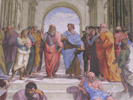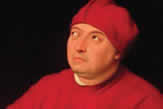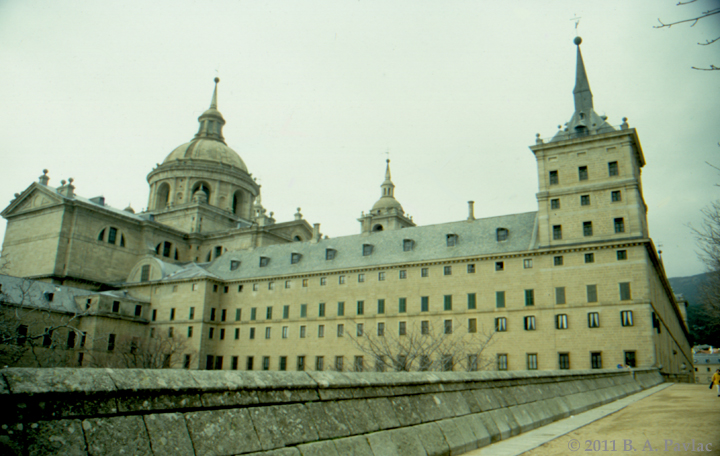Art History for Chapter 9:
Making the Modern World: The Renaissance and Reformation, 1400 to 1648
A. RENAISSANCE ART (1400-1600)
Art is basic to understanding the cultural and intellectual revolution called the Renaissance. Inspired by statues and ruins from the classical antiquity of Greece and Rome, artists sought to create art that reflected the naturalistic and realistic view of the human eye. Much effort was put into discovering what techniques the ancients used. As a result, the status of artists grew from that of a simple craftsman to a gifted creator.
Political and religious leaders put much money and effort into sponsoring new works of art in the new style. The Renaissance artists changed the way people looked at world. The world could be measured by humans. Churches commissioned fewer commissioned by churches, compared to lay people, who often wanted portraits.
 The Renaissance began in Florence, sponsored by the Medici banking family. They believed that patronage of art and culture were essential to the modern community.
The Renaissance began in Florence, sponsored by the Medici banking family. They believed that patronage of art and culture were essential to the modern community.
Otherwise the growing emphasis on the portrayals of this world proved irresistable. The encouragement of the new arts and humanities soon spread to other Italian cities. The three greatest Italian Renaissance artists were Leonardo da Vinci (b.1452-d.1519) (with views on his genius here), Michelangelo (b.1475-d.1564 (with digitized materials here), and Raphael (b.1483-d.1520).
Each worked as painters and architects, while Michelangelo excelled at sculpture. Leonardo da Vinci's mind pursued all sorts of experimentation and invention, carefully recorded. His Mona Lisa has become one of the most famous paintings in the world.
Another Renaissance took place in northern Europe, at first in Isle de France, but then it shifted to Netherlands, fostered by wealth of Flemish cities in Flanders and court of Dukes of Burgundy. The Dutch Jan van Eyck (b.c. 1390-d.1441) or the German Albrecht Dürer (b.1471-d.1528) were typical of the north. Hieronymous Bosch
Painting/Graphic Arts
Following the late medieval Italian painter Giotto (1266?-1337) artists continued to move in the direction of realism and naturalism.
The Renaissance artistic drive was to make two-dimensional pictures appear as realistic as possible. The reinvention of rules of perspective (helped by mathematics) and the study of human anatomy (learned by dissection) aided the growth of realistic and naturalistic portrayals of natural subjects.
The painter Sandro Botticelli (b.1445-1510) was known for his beautiful portrayals of women, although late in life he regretted this turn to worldliness and burned some of his own work on the "Bonfire of the Vanities."
The invention of oil-based paints on canvas also allowed for more detailed brushwork that could be done over a long period of revision and correction. Also, since light reflected from different layers of paint, the new technique adding depth and glow.
Raphael's School of Athens in the Vatican captures the heritage of the classics combined with the art of the Renaissance. He was also famous for his madonnas, the best of them the Sistine Madonna  (named after the pope portrayed in the picture). He also did the original for the cover of the first edition of the textbook, a portrait of Cardinal Tommaso "Faedra" Inghirami.
(named after the pope portrayed in the picture). He also did the original for the cover of the first edition of the textbook, a portrait of Cardinal Tommaso "Faedra" Inghirami.
In Venice, the artist Titian (b.c.1490-d.1576) played with the effects of color and light, eventually rising to become the court painter of Emperor Charles V.
Sculpture
Inspired by the art of classical antiquity, Renaissance sculptors sought more realism and character in their works. Their favorite subject was the human form, often nude and free standing, so one could appreciate it from all sides. Donatello (b.1386-d.1466) promoted new naturalism and brought statues out of niches to be viewed in the round.
Perhaps the most famous example is Michelangelo’s David, meant to stand in a plaza in the heart of Florence.
Architecture
In Florence, where the Renaissance began, the finishing of the cupola or dome over the nave of the cathedral was the first great achievement. Other churches using Roman proportions and design elements were built. Architects also designed urban palaces for the powerful Florentine families.
 Other Italian wealthy soon imitated the Florentines. Both Raphael and Michelangelo contributed to the new St. Peter’s Basilica in Rome for the popes.
Other Italian wealthy soon imitated the Florentines. Both Raphael and Michelangelo contributed to the new St. Peter’s Basilica in Rome for the popes.

Reacting against the near perfection reached by Renaissance artists in recreating a calm harmonic reality, some artists in the next generation turned away to create art that can strike us as odd. They sometimes chose odd colors, bizarre subjects, unbalanced compositions, strange light sources, or bodies unnaturally elongated. 
The monster park of Bomarzo contains many strange figures.
The most famous Mannerist is El Greco (Domenikos Theotocopoulos, b.1541-d.1614) from the island of Crete, who did most of his work in Madrid.



